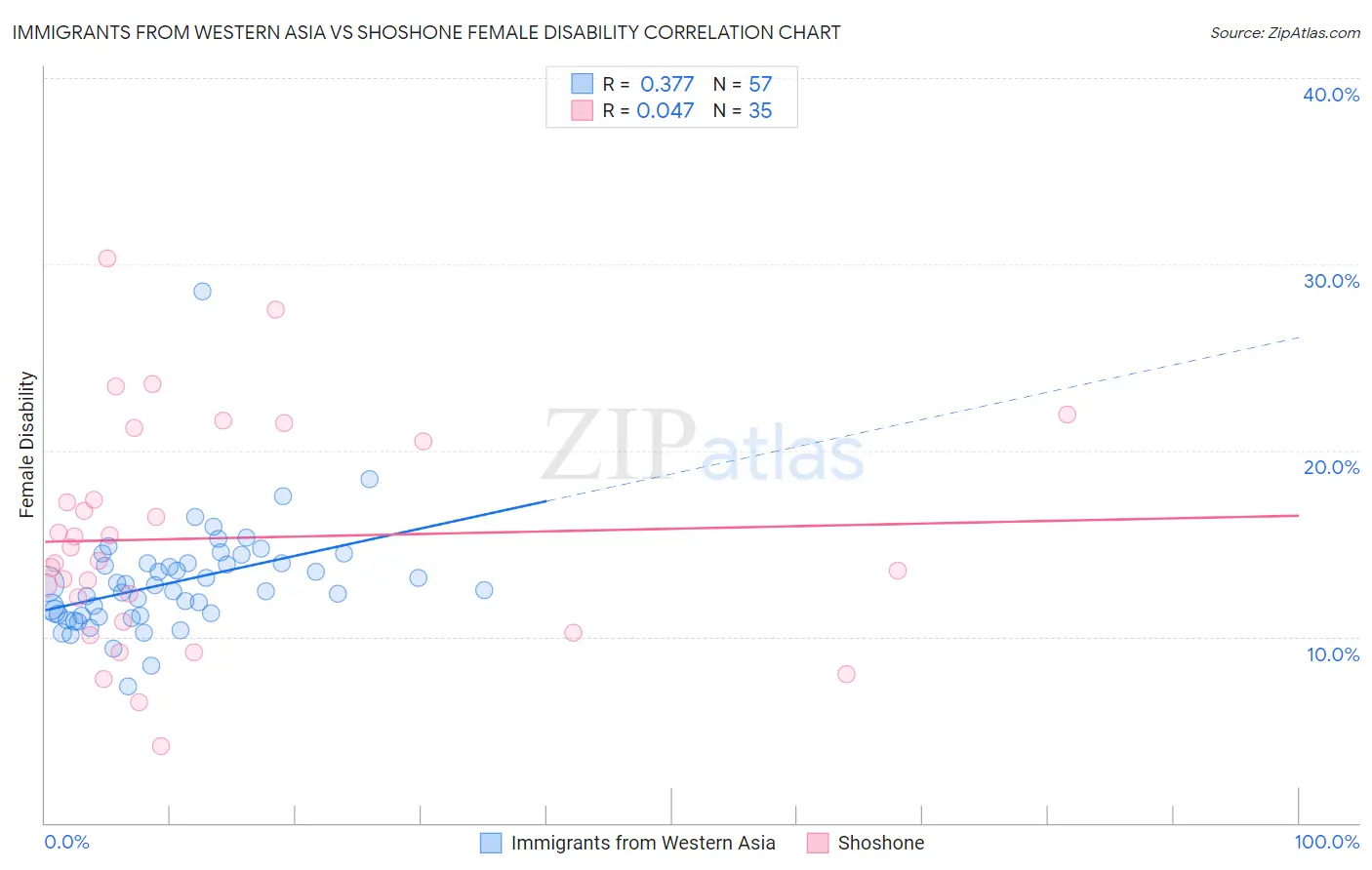Immigrants from Western Asia vs Shoshone Female Disability
COMPARE
Immigrants from Western Asia
Shoshone
Female Disability
Female Disability Comparison
Immigrants from Western Asia
Shoshone
11.7%
FEMALE DISABILITY
98.3/ 100
METRIC RATING
104th/ 347
METRIC RANK
13.2%
FEMALE DISABILITY
0.0/ 100
METRIC RATING
291st/ 347
METRIC RANK
Immigrants from Western Asia vs Shoshone Female Disability Correlation Chart
The statistical analysis conducted on geographies consisting of 404,394,576 people shows a mild positive correlation between the proportion of Immigrants from Western Asia and percentage of females with a disability in the United States with a correlation coefficient (R) of 0.377 and weighted average of 11.7%. Similarly, the statistical analysis conducted on geographies consisting of 66,617,208 people shows no correlation between the proportion of Shoshone and percentage of females with a disability in the United States with a correlation coefficient (R) of 0.047 and weighted average of 13.2%, a difference of 12.7%.

Female Disability Correlation Summary
| Measurement | Immigrants from Western Asia | Shoshone |
| Minimum | 7.3% | 4.1% |
| Maximum | 28.6% | 30.3% |
| Range | 21.3% | 26.2% |
| Mean | 12.9% | 15.3% |
| Median | 12.5% | 14.1% |
| Interquartile 25% (IQ1) | 11.1% | 10.8% |
| Interquartile 75% (IQ3) | 14.0% | 20.5% |
| Interquartile Range (IQR) | 2.8% | 9.7% |
| Standard Deviation (Sample) | 3.0% | 6.0% |
| Standard Deviation (Population) | 2.9% | 5.9% |
Similar Demographics by Female Disability
Demographics Similar to Immigrants from Western Asia by Female Disability
In terms of female disability, the demographic groups most similar to Immigrants from Western Asia are Immigrants from Eastern Africa (11.7%, a difference of 0.010%), Australian (11.7%, a difference of 0.020%), Immigrants from Greece (11.7%, a difference of 0.040%), Latvian (11.7%, a difference of 0.070%), and Immigrants from South Eastern Asia (11.7%, a difference of 0.080%).
| Demographics | Rating | Rank | Female Disability |
| Koreans | 99.0 /100 | #97 | Exceptional 11.7% |
| Uruguayans | 98.8 /100 | #98 | Exceptional 11.7% |
| Immigrants | Philippines | 98.6 /100 | #99 | Exceptional 11.7% |
| Immigrants | Uruguay | 98.5 /100 | #100 | Exceptional 11.7% |
| Immigrants | Costa Rica | 98.4 /100 | #101 | Exceptional 11.7% |
| Immigrants | South Eastern Asia | 98.4 /100 | #102 | Exceptional 11.7% |
| Immigrants | Eastern Africa | 98.3 /100 | #103 | Exceptional 11.7% |
| Immigrants | Western Asia | 98.3 /100 | #104 | Exceptional 11.7% |
| Australians | 98.3 /100 | #105 | Exceptional 11.7% |
| Immigrants | Greece | 98.2 /100 | #106 | Exceptional 11.7% |
| Latvians | 98.2 /100 | #107 | Exceptional 11.7% |
| New Zealanders | 98.1 /100 | #108 | Exceptional 11.7% |
| Immigrants | Immigrants | 98.1 /100 | #109 | Exceptional 11.7% |
| Soviet Union | 98.1 /100 | #110 | Exceptional 11.7% |
| Costa Ricans | 98.1 /100 | #111 | Exceptional 11.7% |
Demographics Similar to Shoshone by Female Disability
In terms of female disability, the demographic groups most similar to Shoshone are Tlingit-Haida (13.2%, a difference of 0.060%), Immigrants from Yemen (13.2%, a difference of 0.060%), Yakama (13.2%, a difference of 0.17%), White/Caucasian (13.2%, a difference of 0.24%), and Yaqui (13.2%, a difference of 0.34%).
| Demographics | Rating | Rank | Female Disability |
| Hmong | 0.0 /100 | #284 | Tragic 13.1% |
| Bangladeshis | 0.0 /100 | #285 | Tragic 13.1% |
| Fijians | 0.0 /100 | #286 | Tragic 13.1% |
| Yaqui | 0.0 /100 | #287 | Tragic 13.2% |
| Whites/Caucasians | 0.0 /100 | #288 | Tragic 13.2% |
| Tlingit-Haida | 0.0 /100 | #289 | Tragic 13.2% |
| Immigrants | Yemen | 0.0 /100 | #290 | Tragic 13.2% |
| Shoshone | 0.0 /100 | #291 | Tragic 13.2% |
| Yakama | 0.0 /100 | #292 | Tragic 13.2% |
| Marshallese | 0.0 /100 | #293 | Tragic 13.3% |
| Celtics | 0.0 /100 | #294 | Tragic 13.3% |
| French | 0.0 /100 | #295 | Tragic 13.3% |
| Nepalese | 0.0 /100 | #296 | Tragic 13.3% |
| Slovaks | 0.0 /100 | #297 | Tragic 13.3% |
| Immigrants | Nonimmigrants | 0.0 /100 | #298 | Tragic 13.4% |